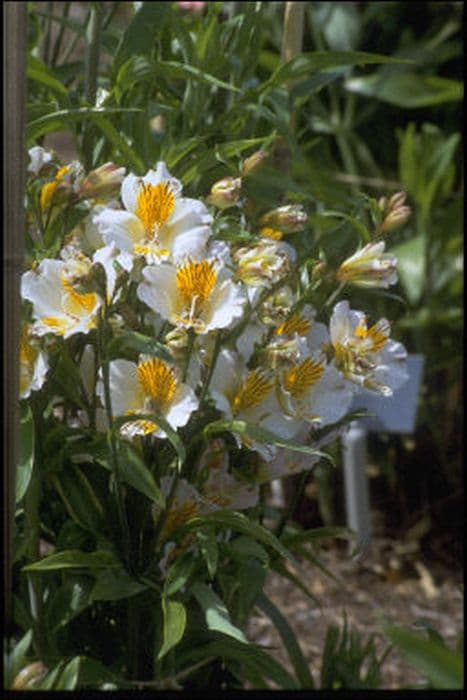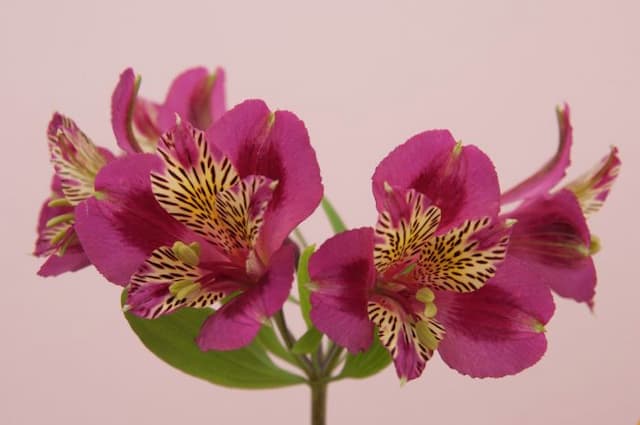Peruvian Lily Alstroemeria 'Yellow Friendship'

ABOUT
Alstroemeria 'Yellow Friendship', often known as Peruvian Lily or Lily of the Incas, is a striking and vibrant plant known for its resplendent flowers and resilient nature. The flowers of this Alstroemeria feature a captivating mix of golden yellow petals, each adorned with streaks or flecks of a contrasting brown, burgundy, or mahogany shade. These distinctive markings add an exotic look to the bloom, resembling an artistic brush stroke. The petals are typically arranged in a clustered fashion, forming a trumpet-like shape that adds textural interest to the plant's appearance. The leaves of 'Yellow Friendship' grow in a lance-shaped or elongated manner, displaying a lush green color that creates a lush backdrop for the luminous flowers. The foliage can sometimes exhibit a unique twisting characteristic, where the leaf twists from the base, presenting the underside of the leaf alongside the top in a helical pattern. This twining attribute contributes an element of whimsical motion to the plant's form. Bright and cheerful, Alstroemeria 'Yellow Friendship' adds a pop of color to any garden space. Its flowers often bloom in clusters atop slender, yet sturdy stems, giving the impression of a bountiful and overflowing bouquet. The plant's overall look is one of both striking beauty and graceful resilience, inviting friends and admirers to gaze upon its sunny and friendly demeanor. Despite the exclusion of its size, the Alstroemeria 'Yellow Friendship' typically has a presence that is both notable and delightfully harmonious when planted among other garden flora.
About this plant
 Names
NamesFamily
Alstroemeriaceae
Synonyms
Peruvian Lily, Lily of the Incas, Parrot Lily
Common names
Alstroemeria 'Yellow Friendship'
 Toxicity
ToxicityTo humans
Peruvian lily is considered to have low toxicity for humans. However, if ingested, it may cause minor symptoms such as nausea, vomiting, or diarrhea. Handling the plant can sometimes result in skin irritation due to the presence of tuliposide A, which is a skin allergen for sensitive individuals.
To pets
Peruvian lily can be toxic to pets, particularly cats and dogs. If ingested, symptoms may include vomiting, diarrhea, and drooling. In more severe cases, ingestion can lead to renal failure, so it's important to prevent pets from eating the plant and to seek veterinary care immediately if they do.
 Characteristics
CharacteristicsLife cycle
Perennials
Foliage type
Evergreen
Color of leaves
Green
Flower color
Yellow
Height
2-3 feet (60-90 cm)
Spread
1-2 feet (30-60 cm)
Plant type
Bulb
Hardiness zones
7
Native area
South America
Benefits
 General Benefits
General Benefits- Long-lasting Blooms: The Alstroemeria, or Peruvian Lily, is renowned for its long-lasting flowers that can remain vibrant for several weeks.
- Attracts Pollinators: Its vibrant yellow flowers are effective at attracting bees and butterflies, which are essential for pollination.
- Aesthetic Appeal: With its striking yellow petals and intricate markings, the Peruvian Lily adds beauty and color to gardens and floral arrangements.
- Drought Tolerance: Once established, the Peruvian Lily is quite drought-tolerant, making it suitable for water-wise gardens.
- Cut Flower Usage: The sturdy stems and long vase life make the Peruvian Lily a preferred choice for cut flower arrangements.
- Low Maintenance: It requires minimal care beyond basic watering and occasional feeding, making it ideal for busy or novice gardeners.
- Versatility in Landscaping: The plant can be used in borders, containers, and as ground cover, offering a flexible option for various garden designs.
 Medical Properties
Medical PropertiesThis plant is not used for medical purposes.
 Air-purifying Qualities
Air-purifying QualitiesThis plant is not specifically known for air purifying qualities.
 Other Uses
Other Uses- Alstroemeria can be used as a natural dye for fabrics, where the pigments from the petals can impart a range of subtle colors.
- The stalks of the Alstroemeria can be woven into small decorative baskets or ornaments when dried and treated properly.
- The petals of the Alstroemeria may be used in the art of pressed flowers, to create delicate and lasting artwork.
- Dried Alstroemeria flowers can be incorporated into homemade potpourri to add an appealing aesthetic and aromatic touch to homes.
- Petals of the Alstroemeria can be used as a natural confetti for outdoor celebrations, as it is biodegradable and environmentally friendly.
- Alstroemeria's strong stems can be used in the practice of plant-based sculptures, offering a framework due to their innate durability.
- The vibrant colors of Alstroemeria flowers make them an excellent tool for teaching children about the color spectrum and plant biology.
- Alstroemeria flowers can be used as bookmarks, with their flattened and dried petals creating a beautiful and organic way to keep one's place in a book.
- The intricate pattern of Alstroemeria petals can be used as inspiration or templates in various forms of art and design, from textile patterns to graphic design fundamentals.
- Deadheaded Alstroemeria blooms can be used as mulch in gardens, providing a source of organic matter that decomposes to add nutrients back into the soil.
Interesting Facts
 Feng Shui
Feng ShuiThe Peruvian lily is not used in Feng Shui practice.
 Zodiac Sign Compitability
Zodiac Sign CompitabilityThe Peruvian lily is not used in astrology practice.
 Plant Symbolism
Plant Symbolism- Friendship: Alstroemerias, also known as Peruvian Lilies or Lily of the Incas, are often symbolized as tokens of friendship due to their long-lasting bloom and supportive stalk, representing the enduring nature of friendships.
- Devotion: These flowers symbolize the mutual support and devotion found in strong relationships, akin to the tightly bound foliage and intricate flower patterns.
- Wealth and Prosperity: With their lush flowers and vibrant color, Peruvian Lilies are commonly associated with wealth and the abundance of prosperity, making them a popular choice for celebratory occasions.
- Achievement and Success: The bright yellow blooms of the Alstroemeria signify accomplishments and success, often used to congratulate someone on achievements.
- Regeneration and Recovery: The rapid growth and renewal of the Alstroemeria's foliage and blooms are emblematic of regeneration and the ability to recover from challenges.
 Water
WaterThe Peruvian Lily should be watered thoroughly, allowing the top inch of soil to dry out between waterings. During the growing season in spring and summer, this typically means watering once a week with approximately 1 gallon of water for a medium-sized plant, depending on the environmental conditions. During fall and winter, reduce watering to every other week or when the soil is dry to touch. Avoid overhead watering to prevent fungal diseases and do not let the plant sit in water as this can lead to root rot. Always check the soil moisture level before watering to ensure the plant is not over-watered.
 Light
LightPeruvian Lilies thrive in bright, indirect light but can also handle direct morning sunlight with some afternoon shade. The best spot for these plants is near an east or west-facing window where they can receive light for at least 6 hours a day. Avoid placing them in full harsh afternoon sun, which can scorch the leaves, or in deep shade, which can hinder bloom production.
 Temperature
TemperaturePeruvian Lilies prefer temperatures between 65 and 80 degrees Fahrenheit during the day and slightly cooler at night, around 50 to 60 degrees Fahrenheit. They can survive temperatures as low as 23 degrees Fahrenheit but frost can damage the plant. Consistent temperature within the preferred range is ideal for encouraging blooms and healthy growth.
 Pruning
PruningPeruvian Lilies benefit from pruning to remove spent flowers and dead foliage, which encourages new growth and more blooms. Prune the plant lightly throughout the growing season as needed, and cut back heavily in late winter or early spring before new growth begins. This is also the best time to cut back any overgrown stems to maintain the shape and size of the plant.
 Cleaning
CleaningAs needed
 Soil
SoilThe Peruvian Lily or Alstroemeria 'Yellow Friendship' thrives in fertile, well-drained soil. A good mix for this plant would be equal parts loam, sand, and peat to ensure proper drainage and aeration. The optimal soil pH for Peruvian Lilies should be slightly acidic to neutral, ranging from 6.0 to 7.0 to encourage the best growth and flowering.
 Repotting
RepottingPeruvian Lilies, including the 'Yellow Friendship' variety, don’t need frequent repotting and can typically be repotted every two to three years. This can be done when growth begins to wane or the plant becomes root-bound, which is common in fast-growing varieties.
 Humidity & Misting
Humidity & MistingPeruvian Lilies like 'Yellow Friendship' flourish at average room humidity levels. Aim for humidity levels between 40% to 60% for the best growth, though they can tolerate slightly lower levels without adverse effects.
 Suitable locations
Suitable locationsIndoor
Provide bright, indirect light and keep at room temperature.
Outdoor
Plant in partial shade with shelter from harsh wind.
Hardiness zone
7-10 USDA
 Life cycle
Life cycleAlstroemeria 'Yellow Friendship', commonly known as Peruvian Lily or Lily of the Incas, begins its life cycle as seed or tuberous rootstock. If propagated from seed, it undergoes germination in a warm, moist environment before developing into a seedling. From the seedling stage, it progresses to vegetative growth, forming a robust root system and foliage. The plant then enters the flowering stage, typically from late spring to early summer, producing yellow flowers that attract pollinators. After pollination, seeds are produced and dispersed, completing the reproductive cycle. With proper care, the Peruvian Lily can survive for years, often going dormant in winter before regrowing in spring.
 Propogation
PropogationPropogation time
Spring to Summer
The Alstroemeria 'Yellow Friendship', commonly known as the Peruvian Lily or Lily of the Incas, can be propagated most effectively through division, which is best done in the spring. To propagate through division, carefully dig up the plant, ensuring you have a sizable clump with several rhizomes, which resemble tubers. Gently separate the clump into smaller sections, each with at least one shoot and a portion of the root system. These divisions can then be replanted at the same depth they were growing at previously, spacing them about 12 inches (approximately 30 centimeters) apart to allow for sufficient room for growth. Water the new plants thoroughly to help establish them. This vegetative method maintains the genetic integrity of the 'Yellow Friendship' cultivar, ensuring that the new plants will be true to the parent's characteristics.





![Peruvian lily [H.R.H. Princess Alice]](/_next/image?url=https%3A%2F%2Fplants-admin.emdemapps.com%2Fimages%2Fplants%2F%2Fimages%2F604b55e81c8b0.png&w=640&q=75)

![Peruvian lily [Inca Coral]](/_next/image?url=https%3A%2F%2Fplants-admin.emdemapps.com%2Fimages%2Fplants%2F%2Fimages%2F604b5b79b85ce.png&w=640&q=75)
![Peruvian lily [Inca Exotica]](/_next/image?url=https%3A%2F%2Fplants-admin.emdemapps.com%2Fimages%2Fplants%2F%2Fimages%2F604b5ec0e34a9.png&w=640&q=75)
![Peruvian lily [Inca Milk]](/_next/image?url=https%3A%2F%2Fplants-admin.emdemapps.com%2Fimages%2Fplants%2F%2Fimages%2F604b5f14b0b6a.png&w=640&q=75)